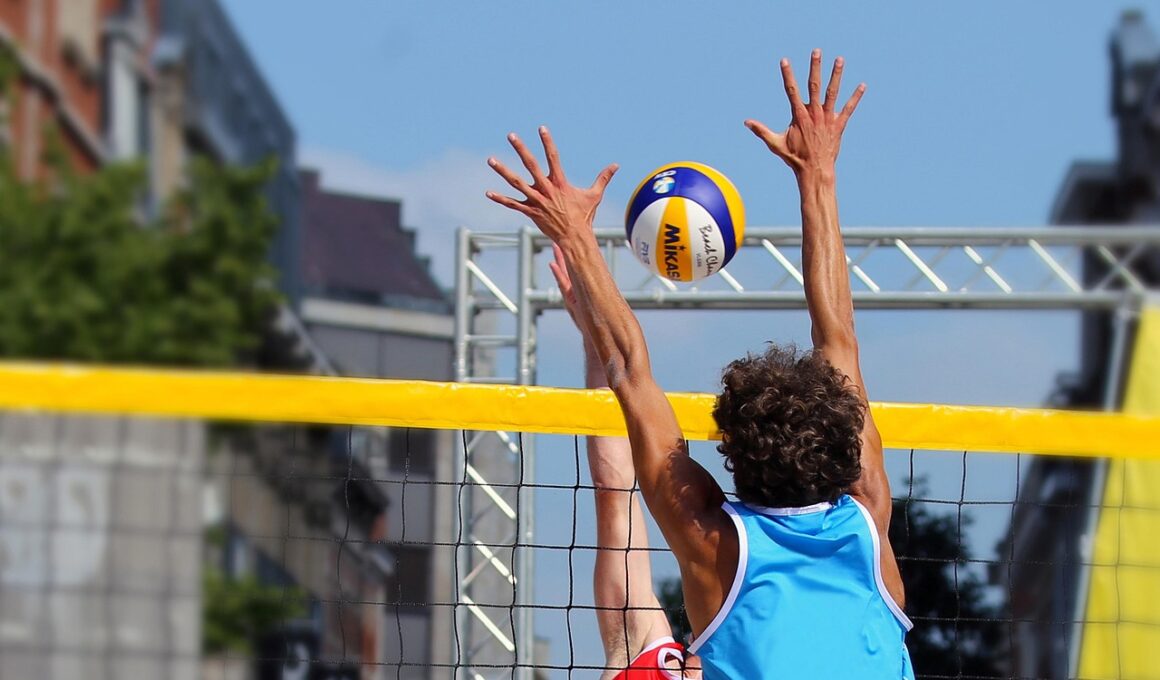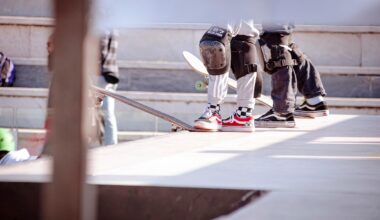Benefits of Watching Professional Volleyball to Learn Blocking
In volleyball, mastering blocking techniques is fundamental to success. Observing professional games offers insights into high-level strategies and tactics employed by expert players. By watching athletes like these, aspiring volleyball players can identify key components of effective blocking. One major benefit is understanding the timing needed for successful executions. Professionals showcase the perfect synchronization required for blocking shots from attackers. Their precise movements demonstrate how to position oneself correctly to maximize impact on the ball. Another advantage is learning how positioning and footwork contribute to an effective block. Athletes exhibit the importance of lateral movement and quick reactions. Delving into the intricacies of blocking techniques proves beneficial. Moreover, players witness different blocking styles, each adaptable to unique playing situations. Observation allows for familiarization with situational awareness and anticipatory skills crucial for anticipating opponents’ actions. Players can also emulate specific blocking drills seen in matches, integrating those principles into their training regimens. Watching top players allows for self-evaluation and identification of areas that require improvement. As such, immersing oneself in professional volleyball is invaluable for amplifying blocking proficiency.
Additionally, analyzing the defensive strategies used by professional teams provides comprehensive learning opportunities. Each match highlights how players communicate and strategize during intense scenarios. For instance, effective communication between blockers and back-row players is essential for successful defense. By observing professional teams, aspiring players can grasp the significance of timely verbal cues. This not only fortifies blocking skills but also enhances overall team dynamics. It illustrates the collective effort required for successful defense. Attending or streaming matches also reveals how coaches implement specific blocking techniques during various phases of the game. Learning from coaches who work at elite levels can guide amateur players in understanding necessary adjustments. Furthermore, players shall appreciate the physical attributes that professional athletes possess. This includes strength, agility, and speed, all vital aspects of executing effective blocks. Players can adapt their physical training to resemble those traits, thereby improving their overall athleticism. Moreover, studying the mental aspects of blocking, such as focus and confidence, is equally relevant. This mental fortitude distinguishes successful blockers in crucial moments of the game. A growth mindset cultivated through observation enhances resilience and adaptability on the court.
Watching matches contributes to understanding opponents’ tendencies, which enhances strategic development for aspiring players too. Analyzing how professionals predict attackers’ moves instills confidence and anticipation in blocking situations. Recognizing different spiking techniques allows players to adapt their blocking strategies. For instance, understanding angle of approach or jump height informs how to adjust one’s block effectively. Additionally, this knowledge can help players diversify their skills to prepare for varying situations they may face on the court. Another key benefit is observing how players recover after a block. A crucial lesson lies in the transition from blocking to offensive plays. Professional athletes quickly shift their focus, ensuring they are prepared for the next moment in the game. These quick adjustments are essential for maintaining momentum. Moreover, studying professional matches allows players to analyze the psychological aspects of blocking. The confidence displayed by expert players is often developed through years of training and experience. Observing their ability to maintain composure offers motivation. It emphasizes the importance of a persistent learning attitude. Players can reflect on their performances, dissecting areas where they can grow. This self-awareness contributes to an overarching environment of continuous improvement.
Incorporating Learnings into Training Regimes
Applying insights gained from watching professional volleyball can fundamentally revolutionize an aspiring player’s training approach. By implementing learned blocking techniques into practice sessions, players become proactive rather than reactive. Strategically, players can create scenarios based on professional footage that simulate game-like situations, which reinforce muscle memory. Practice incorporating blocking against various styles of attacks that professionals demonstrate gives athletes hands-on experience. They can practice foot placement, timing, and arm positioning learned from skilled players. Regularly reviewing professional matches allows players to refine their strategies continuously. This iterative process solidifies skills while introducing new blocking concepts that keep training engaging. Furthermore, aspiring athletes can form study groups to discuss matches after viewing; sharing insights continuously fosters knowledge retention. Such discussions help emphasize collaborative learning and teamwork, mirroring the professional environment. Recording practice sessions and comparing them with professional footage highlights developmental progress and areas needing adjustments. Encouraging athletes to analyze their moments alongside professional performances cultivates accountability and personal growth. Integrating these methodologies into everyday training elevates players’ games, bridging knowledge gained from observation into tangible results on the court.
The social aspect of engaging with fellow volleyball enthusiasts enhances the learning experience while watching professional games. By attending matches or participating in discussions online, players build a supportive community that fuels inspiration and motivation. Engaging with other volleyball fans fosters relationships with shared interests, cultivating camaraderie and teamwork elements vital to the sport. These interactions facilitate collaborative learning as players exchange techniques, tips, and personal experiences. Additionally, coaches can motivate the players by sharing notable professional game highlights or strategies. Creating a competitive but constructive atmosphere encourages players to replicate the skills showcased. Group viewings or discussions also serve as informal learning sessions where experts can dissect matches, focusing on blocking strategies. They can share individual perspectives or even personal experiences that correlate. Moreover, social media platforms allow for constant interactions within the volleyball community. Players can document their progress online while seeking insightful feedback. This interconnectedness cultivates a culture of positivity, learning, and collective growth, enhancing the overall volleyball experience. Each shared moment of learning brings individuals closer together, creating a network of informed volleyball players dedicated to excellence.
Furthermore, access to advanced technology provides aspiring volleyball players the opportunity to analyze professional techniques in real-time. Many sports networks and streaming platforms allow viewers to slow down broadcasts, focusing directly on blocking plays. This technological advantage enhances learning experiences, allowing meticulous breakdowns of professional players’ techniques. By closely scrutinizing their movements, aspiring players develop a keen eye for detail that influences their techniques. Studying game footage gives them a distinct perspective of how blockers analyze attacks from spikers. Additionally, they can evaluate the effectiveness of blocking formations when viewed from multiple angles. Engaging analytical tools, such as apps or hardware, permits players to refine skills and gather data on their performances. This data-informed approach allows them to set specific goals and track their progress over time. Along with tracking performance metrics, the ability to review footage fosters critical self-reflection. They can pinpoint where they excel and identify areas needing enhancement. As players consistently adapt to feedback, they cultivate a culture of self-improvement, thereby elevating their blocking skills. Such technological engagement significantly contributes to an all-rounded volleyball education.
The Journey Towards Mastery of Blocking Techniques
The journey towards mastering volleyball blocking techniques is notably enriched by watching professional players in action. Analyzing matches provides numerous benefits. It fuels passion and anticipation for the sport that keeps aspiring players motivated. Each match watched offers new lessons, engaging players in different aspects of blocking strategies and executions. Gathering insights from established professionals inspires players to set ambitious yet achievable goals. As players refine both fundamental and advanced skills, their confidence grows immensely. The graphic representation of successful blocking plays showcases how commitment and dedication yield results. Each instance reinforces their understanding of resilience in overcoming challenges. Importantly, professional volleyball nurtures ambition by displaying high-level competition. Watching elite players energizes a sense of belonging within the sport, encouraging players to strive for improvement. Thus, connecting each experience back to personal growth emphasizes consistency. Whether solo practices or competitive play, they can incorporate techniques learned into every aspect, making adjustment an ongoing process. With time and persistence, aspiring players develop into competent blockers while creating satisfying progress along their journey, leading towards mastery in volleyball.


